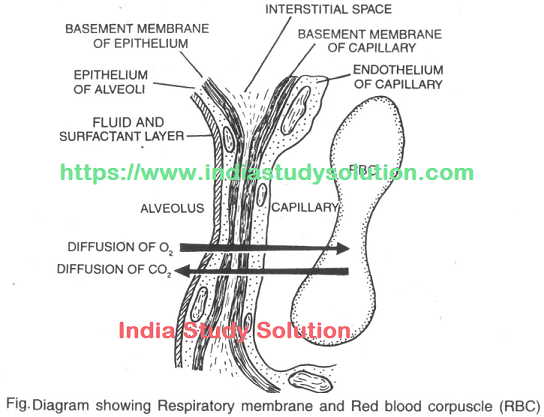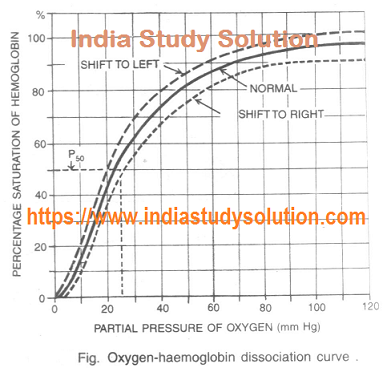HUMAN PHYSIOLOGY (Breathing and Respiration, Exchange of Gases)
India Study Solution Biology (Zoology) Very Long Answer Questions
TQ5 (Q. No.72-75)
Hi Friends,
This is a series of some very important, most carefully selected Very Short type, Medium and then Long Answer type questions followed by our very popular result-oriented India Study Solution MCQ Test Series with their answers and solutions from Biology Chapter - HUMAN PHYSIOLOGY (Breathing and Respiration, Exchange of Gases).
If you are preparing for any Medical Entrance Exam like NEET, MCAT, or any similar Test etc. then please don't skip any question/series. Please go through the previous questions too in our earlier posts through the links given below this post.
If you haven't then Subscribe us to keep yourself updated. It's FREE (Subscribe button is given)
Follow us in Facebook and Twitter
Solved Very Long Answer Biology Questions (Zoology)
Question 72: How does the exchange of gases occur in respiration between blood and alveolar air?
Answer 72: The exchange of gases (i.e., oxygen and carbon dioxide) between lung alveoli and pulmonary capillaries is called external respiration. It occurs as follows:

The wall of the alveoli is very thin and has rich network of blood capillaries. Due to this, the alveolar wall seems to be a sheet of flowing blood and is called respiratory membrane. The respiratory membrane consists mainly of (a) alveolar epithelium, (b) epithelial basement membrane, (c) a thin interstitial space (d) capillary basement membrane and (e) capillary endothelium. All these layers form a membrane of 0.2 mm thickness. The respiratory membrane has a limit of gaseous exchange between alveoli and pulmonary blood. It is called diffusing capacity. The diffusing capacity is defined as the volume of gas, that diffuses through the membrane per minute for a pressure difference of 1 mm Hg. It is further dependent on the solubility of the discussing gases. In other words, at the particular pressure difference, the diffusion of carbon dioxide is 20 times faster than oxygen and that of oxygen is two times faster than nitrogen. The partial pressure of oxygen (PO2) in the alveoli is higher (104 mm Hg) than that in the deoxygenated blood in the capillaries of the pulmonary arteries (95 mm Hg). As the gases diffuse from a higher to a lower concentration, the movement of oxygen us from the alveoli to the blood. The reverse is the case in relation to carbon dioxide.

The partial pressure of carbon dioxide (PCO2) is higher in deoxygenated blood (45 mm Hg) than in alveoli (40 mm Hg), therefore, carbon dioxide passes from the blood to the alveoli. The partial pressure of nitrogen (PN2) is the same (537 mm Hg) in the alveoli as it is in the blood. This condition is maintained because nitrogen as a gas is not used up by the body.
Post continues after the AD -
Question: 73: Discuss the transport of gases (O2 and CO2) in the blood.
Answer 73: Transport of Oxygen in the Blood: Blood carries oxygen from the lungs to the heart and from the heart to various body parts. Oxygen is transported in the following manners:
1. As dissolved gas: About 3% of oxygen in the blood is dissolved in the plasma which carries oxygen to the body cells.
2. As oxyhaemoglbin: About 97% of oxygen is carried in combination with haemoglobin of the erythrocytes. Haemoglobin (Hb) consists of a protein called globin and a pigment portion called heme. The heme portion contains four atoms of iron, each capable of combining with a molecule of oxygen. Oxygen and haemoglobin combine in an easily reversible reaction to form oxyhaemogloin (HbO2). Hb + 4O2 Hb (O2)4
Under the high partial pressure, oxygen easily binds with haemoglobin in the pulmonary (lung) blood capillaries. When this oxygenated blood reaches the different tissues, the partial pressure of oxygen declines and the bonds holding oxygen to haemoglobin become unstable. As a result, oxygen is released from the blood capillaries.
Oxygen-haemoglobin Dissociation Curve: The amount of oxygen that can bind with haemoglobin is determined by oxygen tension. This is expressed as partial pressure of oxygen (PO2). The percentage of haemoglobin that is bound with O2 is called percentage saturation of haemoglobin. The relationship between the partial pressure of oxygen (PO2) and percentage saturation of the haemoglobin with oxygen (O2) is graphically illustrated by a curve called oxygen-haemoglobin dissociation curve (also called oxygen dissociation curve).Under normal conditions, the oxygen-haemoglobin dissociation curve is sigmoid shaped or "S" shaped.
Factors affecting oxygen-haemoglobin dissociation curve: It is shifted either to left or right by various factors-
1. Shift to Right: Shift to right indicates dissociation of oxygen from haemoglobin.
2. Shift to Left: Shift to left indicates acceptance (association) of oxygen by haemoglobin.
3. Bohr Effect: Shifting of the oxygen haemoglobin dissociation curve to the right by increasing carbon dioxide partial pressure is known as Bohr Effect.
Transport of carbon dioxide: In the oxidation of food, carbon dioxide, water and energy are produced. Carbon dioxide in gaseous form diffuses out of the cells into the capillaries, where it is transported in three ways-
(a). Through blood plasma: Carbon dioxide is transported through this medium in a very little quantity. CO2 combines with water of plasma in presence of carbonic anhydrase enzyme to form carbonic acid.
This soon dissociate into H+ and HCO3-ions. Very little % of CO2 is transported through this method as increased production of carbonic acid increases pH from 7.4 - 4.0.
CO2 + H2O <------> H2CO3 <-----> H+ + HCO3-
(b). By haemoglobin: CO2 combines with haemoglobin to form carbaminohaemoglobin.
Hb + CO2 <-----> HbCO2
carbaminohaemoglobin
About 30% of CO2 is transported by above 2 methods.
(c). As bicarbonates: About 70% of CO2 is transported as bicarbonates. Initially, in the RBC potassium haemoglobin dissociates into K+ + Hb.CO2 when diffuses in the RBC combines with water of the cytoplasm to form carbonic acid which dissociates into H+ and HCO3-ions. Haemoglobin combine with H+ ions to form haemoglobin acid. While in the plasma same CO2 combines worth water of the plasma to form carbonic acid which forms H+ and HCO3-ions. NaCl dissociates into Na+ + Cl-.
Also Read
Question: 74: Describe how the contraction and relaxation of some skeletal muscles produce respiratory movements.
Answer 74: During exercise forceful expiration take place in which with relaxation inspiratory muscles, contraction of expiratory or respiratory muscles takes place. These muscles are of two place:
1. Abdominal muscles
2. IICM
When abdominal muscles contract, visceral organs of abdominal cavity push diaphragm upwards. So, it become more dome shape. When IICM contract ribs and sternum shift downward and inward. By contraction in both muscles volume of thoracic cavity decrease more and intrapulmonary pressure increase more, so, more expiration occur through respiratory tract called forceful expiration.
Question: 75: Write in detail about various respiratory disorders.
Answer 75: Various respiratory disorders are as follows-
Bronchial Asthma: It is an allergy caused by some allergens like pollen grain, dust particle. Allergen stimulate mast cells to produce histamine that causes contraction of smooth muscles of bronchi. Symptoms-coughing, difficulty in breathing mainly during expiration, breathing with wheezing sound, excess mucus secretion from respiratory tract that may clog bronchi and bronchiole.
Emphysema: Emphysema is an abnormal distension of bronchi, bronchiole and alveolar sac of the lungs mainly due to cigarette smoking. Tifr sepia between alveoli are dissolves and elastic tissue replaced by fibrous connective tissue so that lung become non-elastic. Respiratory surface of lung reduced, bronchiole become non-elastic, alveoli remain filled with air even after exhalation.
Bronchitis: Inflammation of the bronchi due to cigarette smoking, air pollutant like CO and Microbial infection.
Pneumonia: It is an acute infection and inflammation of the lung alveoli by S.pneumonae, Mycoplasma, and some false yeast. Infant, young ones, HIV patient are more sensitive for pneumonia. Symptoms- The alveoli becomes acutely inflammated, most of the air space filled with mucus and fluid with WBC.
Occupational lung diseases: These disorders are caused due to exposure of potentially harmful substances, such as gas, fumes or dusts, present in the environment where a person works.
(a). Silicosis and asbestosis: These are common examples, which occur due to chronic exposure of silica and asbestos dust in the mining industry.
(b). Pneumoconiosis: It is found in coal workers.
(c). Byssinosis: It is found in workers of cotton industry.
Breathing and Respiration, Exchange of Gases - More Practice Questions
<<Prev (Q.No 68 - 71) (Q.No - ) Next>>

























